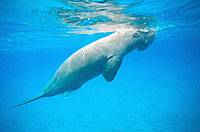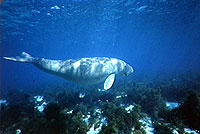 |
.Dugong are large herbivorous marine mammals that belong to the order Sirenia. Four of the five modern members of Sirenia are vulnerable, with the fifth, (Steller’s sea cow), being extinct.
Dugong, which inhabit the shallow sea grass beds common across northern Australia, face a number of anthropogenic pressures including accidental capture in nets, boat strikes, Indigenous hunting, habitat degradation, noise, and underwater explosions. Dugong are particularly susceptible to direct adult mortality as they are long-lived, (70 yrs), late maturing (7-13 years) and slow breeding, (3 – 7 yr calving interval). |

Dugong surfacing to breathe
Courtesy of the Great Barrier Reef
Marine Park Authority |




